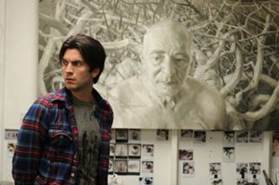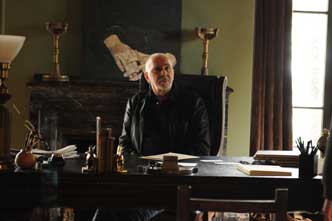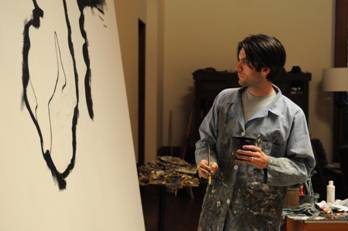By: debbie lynn elias
Written and directed by first-time feature helmer Nenad Cicin-Sain, The Time Being is a moody and meditative performance piece set within and against stunning visuals, creating a simple yet elegant emotional palette for the relationship between Daniel, a struggling young artist, and Warner, a reclusive elder millionaire whom Daniel hopes will give him a commission. On Warner’s initial gallery purchase of one of Daniel’s paintings, Daniel gets the inflated idea that Warner will not only want to buy more of his works, but become his sole benefactor. With money problems at home that are putting stress on an apparently fragile marriage, despite Daniel’s artistic efforts, his talent has not garnered him the acclaim or earnings he needs. Now seemingly forced to choose between his art and his family, Daniel sees Warner as a last hope or cash cow.
But instead of the much needed commission to support Daniel’s financially-strapped and emotionally crumbling family, Warner instead offers him curious and specific photo-video assignments that seem more like surveillance than art. At first blush, although strange, Daniel accepts the first assignment as his art is a meld of photography and oil work with the photo serving as inspiration for the canvas; and he needs the $1,000.00 pay. But the assignments become more bizarre, raising suspicion within Daniel. Curious as to Warner’s intentions and fearing they may fall on the criminal side, he does some of his own digging, as well as making unannounced visits to Warner’s mansion.
As Daniel and Warner start to build on their business relationship, like the break of day, truths come to light through underlying themes of family, art, sacrifice, selfishness and selflessness, as we come to learn that Warner is neither who or what he seems and that he and Daniel may have more in common than Daniel would like to believe.
Almost a cautionary tale from one generation to the next, will Daniel recognize the mistakes of Warner’s life that he is also now seemingly duplicating or will Daniel ignore life’s lessons and a chance for finding his true self before it’s too late?

Not the first person one might think of for the role of Daniel, within moments of seeing him on screen – and especially interacting with Frank Langella, you just know Wes Bentley is the perfect actor for the role. Bringing a quiet, brooding and even mysterious curiosity to the role, Bentley is completely immersive. Crediting the appeal of the script to his real life role as a father, Bentley connected with the character of Daniel and that aspect of which is more important – being a good dad or an actor – “which is kind of the struggle that they are having in The Time Being. It’s one of the themes. I thought that was interesting. And it made me a bit emotional. The line where Daniel says, ‘I need my family’, hit home.” But where Bentley truly excels is his chemistry and dynamic with Frank Langella.
Approaching Daniel by developing his own backstory, “I saw Daniel as an abandoned child, either emotionally or literally, and didn’t have that father figure there which is why he’s not very good at it himself and also why he attaches himself to Warner and he has that immediate respect for him, so he fills that void for a bit. In one way he’s respectful to him, in other ways he’s defiant with him which is good because there’s a bit of a father figure there. Artistically there’s a father figure there.” It’s that untold backstory and Bentley’s own personal connection with Langella that lay the groundwork for their onscreen relationship.

As Warner, Langella is a tower of quiet emotional strength, an emotional force to be reckoned with. Calmingly imposing, Langella’s mere presence on screen demands a tacit and humbling respect that is palpable to the audience. Enhancing that aura of respect are Bentley’s own unconscious inflections within his performance and scenes with Langella, most notably, Daniel rising from a seated position whenever Warner comes into a room, sitting up straighter as if just reprimanded by a parent or teacher. The tiniest and seemingly unimportant elements, yet respectful symbols that are not only very elegant but add another layer to the story. Most telling is Langella’s voice which ranges from wistful to heavy sadness as he yearns for another time, feels the burden of defeat and the costly wisdom of age.
Adding her own voice to the emotional gravitas of The Time Being is Sarah Paulson. As art gallery consultant and single mother Sarah, Paulson has even less dialogue than Bentley and Langella and relies on the strength of nuanced facial expressiveness. Her eyes speak volumes as she moves with a casual focused deliberateness. Although probably most familiar for her lighter Hallmark and Lifetime tv movies, seeing Paulson evoke this powerful dramatic emotion is enthralling, reminding us of her depth and breadth as an actress.

From the opening frame of The Time Being, one knows the visuals will be dramatic, compelling and even cryptic, creating a captivating allure. Co-written by Nenad Cicin-Sain and Richard Gladstein, The Time Being also marks Cicin-Sain’s feature debut as a director. Known for commercial work and music videos, it is more than evident that that is where his strength lies. Every frame, every image is so perfectly constructed, each could be lifted from the film and made into a still image to be framed and hung on a wall. Cicin-Sain’s desire to make a very artistic film and have “everything to look like a painting” was one of the attractions of the project for Wes Bentley.
Where Cicin-Sain falls short, however, is within the story construction, and even character development. Structuring the film with little dialogue, much is left for the audience to “figure out” as just to the very basics of the characters which creates a disconnect for the audience, particularly as to Daniel’s family. There is no exposition, resulting in an empty plot point. Thankfully, the visual artistry carries one through the first 30 minutes or so of the film until Bentley and Langella start getting to the heart of the story, developing a thoughtful intensity that captivates.
Celebratory is the cinematography of Mihai Malaimare, Jr., who makes every frame look just like a painting. Knowing how to use light to its best advantage, Malaimare’s framing then showcases the space be it a playground, a white on white or bricked gallery, a heavy dark mansion or sunny greens and yellows of a garden, with each shot at often interesting angles. One of the most beautiful and striking shots comes from shooting through the back of a canvas while Bentley is painting the front.

Adding to the ambient nature of the characters and setting, as well as authenticity, artists Eric Zener and Stephen Wright were called upon to not only create paintings for the film, but work with Bentley, teaching him some technique both with charcoal sketching and oil painting, not to mention, blocking a canvas. “They showed me how to build a painting from the back. . .[W]hen we made the paintings it was a back and forth. I would do a bit on the camera and then one of them would come in and start working a bit on it while we shot something else. Then I would come in and do more and then he would show me something else to do.”
With visual artistry at its finest, The Time Being is an emotionally heart-wrenching work that establishes Nenad Cicin-Sain as a visual storyteller. It will be interesting to see if he can grow as a filmmaker and hone his writing and dialogue skills to match the beauty and emotion of his pictures.
Directed by Nenad Cicin-Sain
Written by Nenad Cicin-Sain and Richard N. Gladstein
Cast: Wes Bentley, Frank Langella, Sarah Paulson











